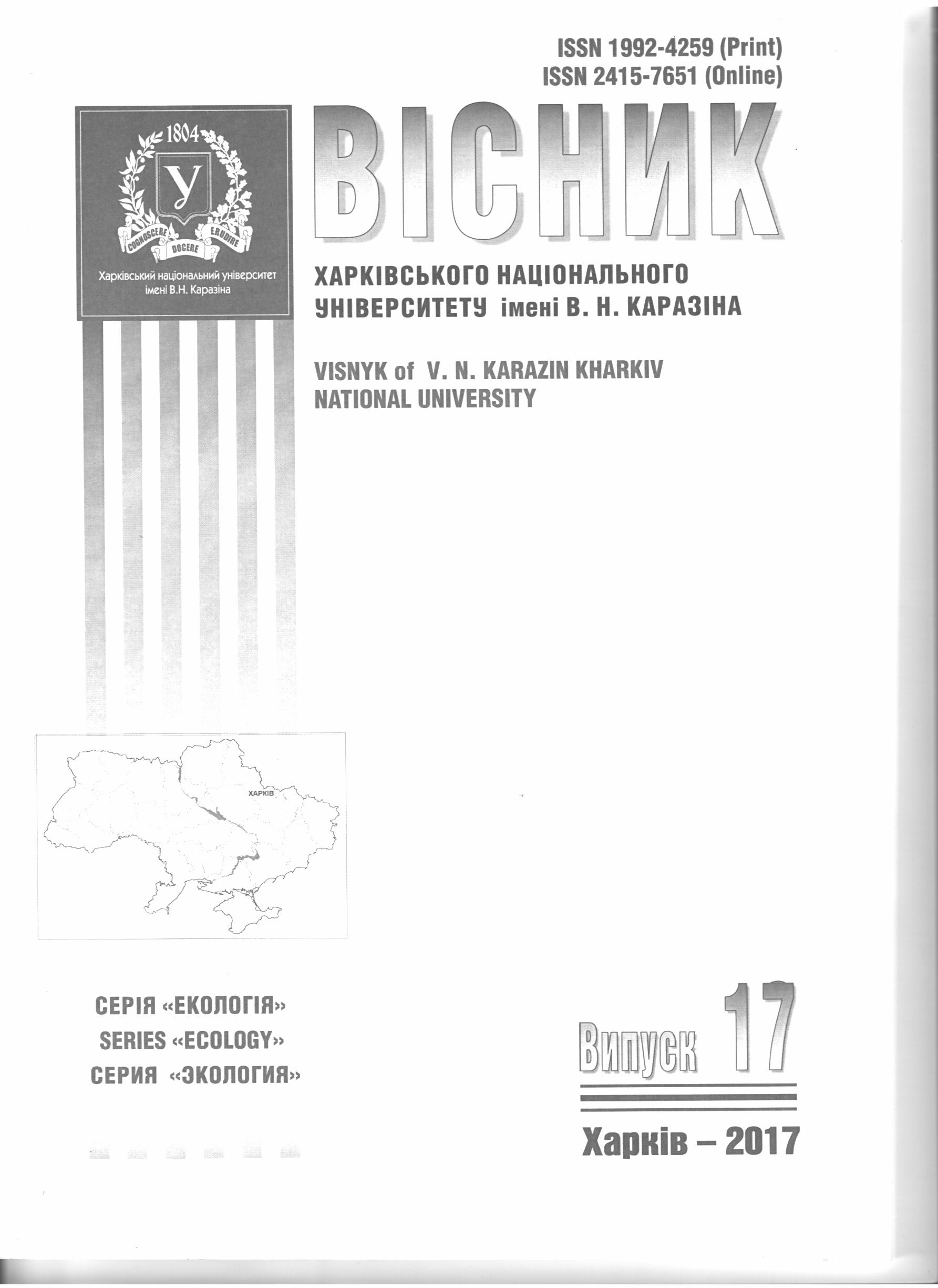Features of constituents in the Kuyalnyk estuary groundwater inflow
Abstract
Purpose. To establish current features in the hydrological regime of aquifers and respective constituents of the estuary inflow with groundwater based on many years’ observations in order make the Kuyalnyk Estuary water balance qualitative assessment more precise. Methods. Hydrodynamic methods of groundwater specific discharge calculation depending on spatial and temporal changes of the estuary flow and water level were used. Results. To establish the regularities of groundwater regime in 2015 a network of hydrogeological wells was equipped in the Kuyalnyk Estuary floodplain (villages Kovalivka – Stara Emetivka). It has been established from the results of the observations of 2015 – 2017 that there is the close hydraulic connection between groundwater and surface water of the estuary; it has also been established, that the specific inflow of groundwater from the eastern bank prevail over that from the western bank. Results of calculation of the underflow specific discharge in the upper reaches of the estuary are showing that during dry periods water losses from the estuary to form the reverse direction underflow take place. Specific discharge of groundwater flow from the sea through alluvial deposition of bay-bar was estimated, as well as specific discharge of groundwater flowing from the sides of the estuary valley (aquifers in wind-born and diluvial deposition of middle and upper Pleistocene in interfluvial plain, Kuyalnyk Stage and Pontic horizon). As of 2016 -2017, average annual volume of all the constituents of groundwater inflow to the Kuyalnyk Estuary equaled to 17-20 cm increase of the estuary level and in comparison with the estuary volume in 2016 made around 35 - 50 %. Conclusions. Estimating the Kuyalnyk Estuary water balance, spatial and temporal changes of all constituents of groundwater inflow volume should be taken into account together with the traditional factors of its hydrological regime forming (precipitation, river and side discharge, evaporation).
Downloads
References
2. Адабовский В.В., Богатова Ю.И. Особенности современного гидролого-гидрохимического режима Куяльницкого лимана и прогнозная оценка его составляющих в условиях возможного пополнения во-доема морскими и пресными водами. Український гідрометеорологічний журнал 2013. №3. С.127-137.
3. Эннан А. А., Шихалеев И. И., Шихалеева Г. Н. , Адобовский В. В., Кирюшкина А. Н. Причины и пос-ледствия деградации Куяльницкого лимана (северо-западное Причерноморье, Украина). Вісн. Одес. нац. ун-ту. Хімія. 2014. 19, вип. 3. С. 60-69.
4. Водний режим та гідроекологічні характеристики Куяльницького лиману: Монографія / За ред.. Н. С. Лободи, Є. Д. Гопченка. Одеса : ТЕС, 2016. 332 с.
5. Геоэкологический анализ ситуации и разработка схем мероприятий по улучшению водно-солевого режима Куяльницкого лимана. Отчет о научно-исследовательской работе. Под ред. Г.И. Швебса. Одесский государственный университет имени И.И. Мечникова. Одесса, 1995. 195 с.
6. Черкез Є.А., Медінець В.І., Тюреміна В.Г., Праведний В.М. Оцінка обсягів субаквального живлення Куяльницького лиману підземними водами. Людина та довкілля. Проблеми неоекології. 2017. № 3-4 (28). В друці
7. Mедінець В.І. Біологічні наслідки поповнення Куяльницького лиману морською водою з Одеської затоки / В.І. Mедінець, Н.В. Ковальова, Н.В. Дерезюк, С.М. Снігірьов, Є.А. Черкез, С.В. Медінець, Є.І. Газетов // Людина та довкілля. Проблеми неоекології. 2017. № 1-2 (27). C. 35-51.
8. Камзіст Ж.С., Шевченко О.Л. Гідрогеологія України. Навчальний посібник. Київ: Фірма «ІНКОС», 2009. 614 с.
9. Геология шельфа УССР. Лиманы / Молодых И.И., Усенко В.П., Палатная Н.Н. и др. – Киев: Наук. думка, 1984 – 176 с.
10. Водообмен в гидрогеологических структурах Украины: Водообмен в нарушенных условиях / Шестопалов В.М., Огняник Н.С., Дробноход Н.И. и др; Отв. ред. Шестопалов В.М.; АН УССР. Ин-т геоло-гических наук. Киев : Наук. Думка, 1991. 528 с.
11. Водообмен в гидрогеологических структурах Украины: Методы изучения водообмена / Шестопалов В.М., Огняник Н.С., Дробноход Н.И. и др; Отв. ред. Шестопалов В.М.; АН УССР. Ин-т геологических наук. Киев : Наук. Думка, 1991. 272 с.
12. Гончар Г.Я. Північно-західна частина Чорного моря – область розвантаження підземних вод. Геологія узбережжя і дна Чорного та Азовського морів в межах УРСР. Видавництво Київського університету. Вип. 5. 1972. С 91-96.
13. Гончар Г.Я. Гідродинамічні та гідрохімічні градієнти підземних вод північно-західного Причорномор’я. Геологія узбережжя і дна Чорного та Азовського морів в межах УРСР. Видавниче об’єднання «Вища школа». Вип. 8. Київ. 1975. С 67-73.
14. Гидрогеология. Под ред. В.М. Шестакова и М.С. Орлова. – М., Изд-во МГУ, 1984. 317 с.
15. Черкез Е.А., Шмуратко В.И., Вахрушев О.А. Ротационно-фильтрационная модель водного баланса Куяльницкого лимана. Матеріали Всеукраїнської науково-практичної конференції ”Лимани північно-західного Причономор`я: актуальні гідроекологічні проблеми та шляхи їх вирішення” 12-14 вересня 2012 р. Україна, м.Одеса. ОДЕКУ. 2012. С. 47 – 51.
16. Ротационная динамика и уровни воды Куяльницкого лимана и верхнесарматского водоносного горизонта / В.В. Додин, А.Р. Погосян, В.Н.Праведный, Е.А. Черкез, В.И. Мединец, О.А. Буняк // Матеріали Всеукраїнської науково-практичної конференції “Лимани північно-західного Причорномор’я: сучасний гідроекологічн / ий стан, проблеми водного та екологічного менеджменту та шляхи їх вирішення ”1-3 жовтня 2014 р.– Одеса: ОДЕКУ, 2014.С. 75-77.
17. Семенов В.Г. Эксплуатационная разведка и переоценка запасов лечебно-столовых вод «Куяльник» Куяльницкого месторождения в Одесской области. Причорномор ДРГП, м.Одеса, 1999. 352 с.
Authors who publish with this journal agree to the following terms:
- Authors retain copyright and grant the journal right of first publication of this work under the terms of a license Creative Commons Attribution License 4.0 International (CC BY 4.0).
- Authors are able to enter into separate, additional contractual arrangements for the non-exclusive distribution of the journal's published version of the work (e.g., post it to an institutional repository or publish it in a book), with an acknowledgement of its initial publication in this journal.
- Authors are permitted and encouraged to post their work online (e.g., in institutional repositories or on their website) prior to and during the submission process, as it can lead to productive exchanges, as well as earlier and greater citation of published work.





